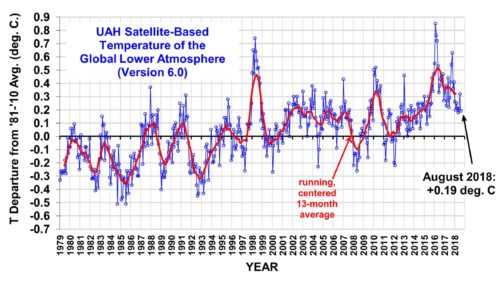 Another week, another New York Times feature trying to get its readers worried about how much the world could warm in the future.
Another week, another New York Times feature trying to get its readers worried about how much the world could warm in the future.
This time The NYTimes partnered with the Climate Impact Lab, which is “a group of climate scientists, economists and data analysts from the Rhodium Group, the University of Chicago, Rutgers University and the University of California, Berkeley,” the paper noted.
The NYTimes and Climate Impact Lab created a graphic that’s supposed to show readers how many more days at or above 90 degrees they could expect today in their hometown from when they were born — their data only goes back to 1960, though.
The question is: how accurate is The NYTimes’ representation of the change in days at or above 90 degrees? Well, at least for U.S. cities, it seems to be misleading.
“This is [a] waste of time,” quipped Dr. Ryan Maue, a Cato Institute adjunct scholar, in a tweet sent out Sunday night. Maue ran the numbers for Atlanta and got a different answer than what The NYTimes showed for the city.
https://twitter.com/RyanMaue/status/1036427124528300032
Here’s what The NYTimes told showed readers who grew up in Atlanta:
So, why is there a difference between the observed record and what The NYTimes reports?
One reason is that The NYTimes uses a “21-year rolling average” to tell readers how many hot days they could expect the year they were born — not the actual number that was observed.
The second reason is that The NYTimes’ data past 2000 is blended with a climate model tuned to future climate projections. After 2020, The NYTimes notes, “the data uses a mixed climate model that captures a broad range of extreme temperature responses.”
“The future projection shown here assumes countries will curb greenhouse gas emissions roughly in line with the world’s original Paris Agreement pledges,” The NYTimes notes.
What’s also apparent is the starting point for The NYTimes’ data is in 1960 at the beginning of a rash of years with relatively few days with soaring temperatures. By starting their data in 1960, The NYTimes ignores the decades before with a number of 90 degree days on par with today.
However, The NYTimes uses this model-blended data to claim Atlanta “is likely to feel this extra heat even if countries take action to lower their emissions by the end of the century.” The paper quotes experts who warn that human health and agriculture will suffer as a result.
“If it’s also humid, humans can’t physiologically evaporate sweat as easily, and we can’t cool down our bodies effectively,” Climate Impact Lab’s Kelly McCusker told The NYTimes.
“Food, water, energy, transportation, and ecosystems will be affected both in cities and the country. High-temperature health effects will strike the most vulnerable,” echoed the group’s leader Cynthia Rosenzweig, a scientist at the NASA Goddard Institute for Space Studies.
While future warming is up for debate, what’s not is the historical record. The NYTimes’ model-blended temperature charts cities around the country, however, doesn’t seem to reflect the actual number of days at or above 90 degrees — at least in the U.S. where there is a robust temperature record.
Maue also examined station data from Washington, D.C. and again found it looked nothing like The NYTimes’ ominous graphic showing a drastic increase in the number of hot days people can expect.
Washington DC (Reagan) since 1940
90F days in a given year.But again, 90F is basically the average temperature in mid-summer. Bleh. pic.twitter.com/3jKHHAJJCc
— Ryan Maue | weathermodels.com (@RyanMaue) September 3, 2018
Again, notice that The NYTimes’ starting date of 1960 is around a low point in the number of 90 degrees or higher days. D.C.’s data only goes back to 1940, so it’s not as long as many other thermometers in other cities.
If The NYTimes wanted to exaggerate a trend toward more 90 degrees or hotter days, then starting in 1960 would accomplish that, but doing so ignores the warm period during the 1930s.
In fact, the latest National Climate Assessment report noted the “Dust Bowl era of the 1930s remains the peak period for extreme heat.”
That heat is also evident in heat wave data presented by the Environmental Protection Agency (EPA). No other decade even comes close to the 1930s in terms of the heat wave index.
Readers should use The NYTimes’ temperature tool to check out modeled trends for their own hometowns, then compare it to observed temperature data. The results could be surprising.
Read more at Daily Caller



















I have sent them many corrections proving beyond any doubt that it is scientifically impossible for CO2 to cause global warming and they just blow it off. For the record the weight of CO2 is 152% heavier than air and does not rise into the atmosphere. That is why they put it in fire exqinquishers because it sinks to the ground and starves the fire from oxygen
The owners and senior managements of the NY Times are working hard to make it extinct . The question is why ? Pension liabilities and bad bets on the next big thing ?
They consistently insult the readers with arrogant preaching and are going down as a result .
The Time’s article goes beyond manipulating the data is to the point of lying. This is as far as historical data. Of course it is well known that the IPCC predictions are faulty, so blending data with them guarantees wrong results.
The New York Times as well as most of the mainstream media are very obviously nothing more than a advocate organization for the climate change movement.
Buying reading or subcribing to the NYT’s is a waste since this infamous liberal rag covered up for the crimes against humanity that Russia carried out in post war Europe